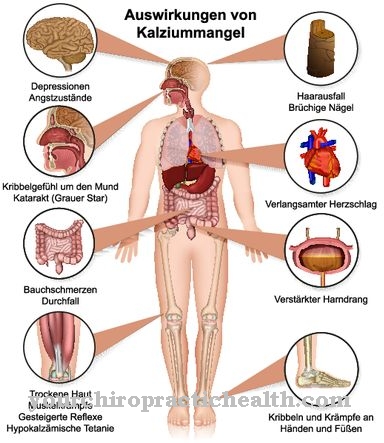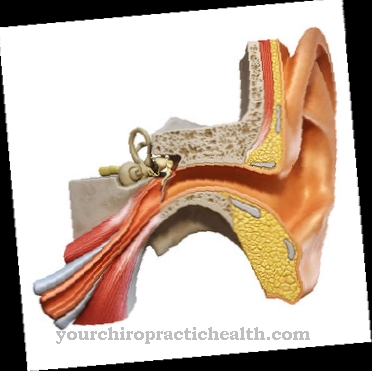Under the term Ciliopathy different genetic diseases are summarized, which cause a malfunction of the cilia or the cells that carry them.
What is ciliopathy?
The cilia (also called cinema cilia) are cytoplasmic protuberances of the cell. They are up to 10 µm long and up to 0.25 µm. The cilia can move freely and are used to transport liquid and mucus films. The cinema cilia beat evenly one behind the other, which leads to an even flicker current.
This ensures that the liquid or mucus is transported away. In the various diseases that are called Ciliopathies are combined, the cilia or the cells that carry them are damaged, which means that they can no longer perform their tasks to a sufficient extent.
causes
The ciliopathies are genetic diseases. A large number of hereditary diseases can now be assigned to the ciliopathies; for some the final proof has not yet been provided. So ciliopathy is inheritable.
The individual ciliopathies differ considerably from one another, as the cilia are located in many different parts of the human body and perform different tasks there. As a result, the symptoms and diagnosis of the ciliopathies are not uniform, but there is a considerable difference between the individual diseases.
Symptoms, ailments & signs
The symptoms, complaints and signs of a ciliopathy are not uniform, since the ciliopathy is not a closed clinical picture, but is simply an umbrella term for various hereditary diseases of the cilia. For this reason, a standardized diagnosis is not possible. The ciliopathies include a wide variety of diseases with sometimes very different symptoms:
- Kartagener's syndrome
- Meckel-Gruber syndrome
- Joubert syndrome
- Laurence Moon Biedl Bardet Syndrome (LMBBS)
- Nephronophthisis
- Senior Løken Syndrome
- Cyst liver
- Bardet-Biedel syndrome
- Ellis van Creveld syndrome (EVC)
- some types of retinopathy
- certain forms of hydrocephalus
- Oro-facio-digital syndrome type 1 (OFD)
- recessive and dominant hereditary cystic kidneys (ARPKD, ADPKD)
- Medullary Cystic Kidney Disease (ADMCKD)
- Alström Syndrome (ALMS)
- Short Rib Polydactyly Syndrome (SRPS)
- Cranio-ectodermal dysplasia
- asphyxiating thoracic dysplasia (ATD)
In the following, the symptoms and diagnosis of Kartagener's syndrome and Laurence-Moon-Biedl-Bardet syndrome (LMBBS) are presented as examples.
Kartagener's syndrome, also known as primary ciliary dyskinesia, is a ciliopthia. In this syndrome there is a dysfunction of the ciliated cells, especially the respiratory ciliated epithelium. The movement of the cilia is disturbed, which is why secretions cannot or not sufficiently be removed.
It follows that the self-cleaning mechanism of the bronchi (mucociliary clearance), which is carried by the respiratory ciliated epithelium, is severely impaired in this syndrome, which is due to the dysfunction of the cilia. The Kartagener syndrome is usually inherited as an autosomal recessive trait.
All cilia-occupied cells of the body are affected, i.e. in addition to the respiratory ciliated epithelium, cells of the ear trumpet (auditory tube) and the paranasal sinuses are also affected. The focus of the symptoms, however, is in the bronchi, which is due to the fact that most of the cilia-occupied cells are to be found there.
In about 50 percent of the patients affected by Katagener syndrome, an abnormal position of the internal organs occurs during the embryonic phase in the form of a situs invertus, a mirror-image arrangement of the organs and vessels. Affected men are mostly sterile due to the disturbed dyskinesia of the sperm. Most women are sterile due to the dyskinesia of the cilia around the fallopian tube.
Most symptoms occur in the respiratory tract. In the course of the disturbed self-cleaning of the bronchi, obstructions and infections of the bronchi often occur. The bronchitis are mostly recurrent and difficult to treat. Furthermore, there are frequent recurrent and poorly treatable rhinitis, sinusitis and otitis media.
In the course of the disease, bronchiectasis, an irreversible expansion of the bronchus, often occurs. Respiratory distress syndrome can occur in newborns. Hydrocephalus, an expansion of the inner or outer liquor spaces, can also occur in newborns.
The Kartagener syndrome is often noticeable by an increased susceptibility to infections in childhood. If there is a situs invertus in addition to an increased susceptibility to infection, the existence of Kartagener's syndrome can be assumed. If the situs invertus is missing, diagnosis is difficult. The evidence of the presence of the Kartagener syndrome is provided by an electron microscopic examination of brush smears or biopsies of the relevant mucous membranes.
A causal therapy is not possible. Treatment is symptomatic. With early diagnosis and adequate therapy, those affected can lead a relatively normal life.
Laurence-Moon-Bardet-Biedl syndrome is also one of the ciliopathies. It is characterized by a wide variety of mutations and malformations that are triggered by mutations on different chromosomes or gene locations. The inheritance is autosomal recessive. A variety of symptoms can occur depending on the genes affected.
These are not equally pronounced in every patient. These symptoms include: obesity; arterial hypertension; Diabetes mellitus; Short stature; Muscle hypotension; Malformations of the liver, ovaries and biliary tract; Hypogonadism; Renal hypoplasia; Kidney failure; Pyelonephritis; motor disorders; mental disability; Retinitis pigmentosa; Blindness; Anosmia; Hearing loss; Hemeralopia; a short neck; noticeable corners of the eyelid; Polydactyly and syndactyly.
The diagnosis of LMBBS is difficult because the symptoms also occur in a variety of other diseases. As with Kartagener's syndrome, the final diagnosis is made using a molecular biological test. There is no causal therapy; treatment is symptomatic.
Diagnosis & course of disease
The diagnosis and course of the disease are not uniform for the different forms of ciliopathies. Symptoms as well as diagnosis and prognosis differed considerably from each other. What the various ciliopathies have in common is that the diagnosis can be confirmed using molecular biological tests.
Complications
As a rule, those affected with ciliopathy suffer from a number of different syndromes and thus from different complications. These also depend very much on the exact severity of the disease, so that it is usually not possible to make a general prediction. First and foremost, ciliopathy leads to an infection in the airways.
This leads to difficulty breathing and possibly shortness of breath. The quality of life of the person affected is significantly reduced, so that it is no longer possible to carry out strenuous activities or sporting activities without further ado. Child development is also delayed by the disease.
In many cases, those affected also very often suffer from inflammation in the nose or airways. Most of those affected also lack the ability to reproduce, so that they also suffer from psychological complaints or depression.
There are no particular complications in the treatment of ciliopathy. However, a complete cure is not possible, so that those affected usually always have to rely on antibiotics and other medications in their lives.
When should you go to the doctor?
If there is a diagnosed hereditary disease within the family, cooperation with a doctor should be sought before planning a possible child. The potential parents should inform themselves comprehensively in advance about risks or likely developments. You should also work closely with a doctor during pregnancy. The preventive examinations offered are to be taken in order to be able to react quickly and comprehensively to possible health impairments.
Since no causal therapies can be used for hereditary diseases, early intervention is particularly important. If there is no knowledge of a family-related genetic mutation, abnormalities are often only noticed by members of the obstetrician team immediately after the birth. In a routine process, the necessary examinations are carried out in order to achieve a diagnosis. At the latest in the development of the child, irregularities can be seen in comparison to peers.
Consult a doctor in the event of optical changes, growth disorders or mental abnormalities. Malfunctions, peculiarities of the reaction and irregularities in the movement sequences must be examined by a doctor. Ciliopathy is an umbrella term for various disorders. Each of them shows individual characteristics in the patient, so that a check-up visit with a doctor should be initiated if there is a suspicion of an existing health discrepancy.
Treatment & Therapy
Causal therapies are not available, the diseases cannot be cured but only alleviated by symptomatic therapy. The therapies for the various ciliopathies are also different.
prevention
These are genetic diseases. A prevention is therefore not possible.
Aftercare
Follow-up care for ciliopathy is primarily based on the type and severity of the disease. Diseases like Laurence-Moon-Biedl-Bardet syndrome or Joubert syndrome cannot be cured. Follow-up care will focus on reviewing treatable symptoms and re-adjusting medication. Since the patients are often chronically ill, there are regular follow-up examinations.
Complaints that have been cured, such as chronic pain or symptoms of intoxication, must be treated with medication. If the ciliopathy is based on a treatable condition such as a cyst kidney, follow-up care depends on the course of the disease and the success of the therapy. If the outcome is positive, the kidney can be transplanted.
After such a kidney transplant, an examination is carried out at weekly intervals in cooperation with the transplant center and the family doctor or specialist. The intervals can later be reduced to four times a year. Part of the follow-up care is the determination of blood values, radiological examinations such as CT or MRI as well as other examinations depending on the underlying disease.
At the same time, the general condition of the patient is always checked. If the ciliopathy is due to other diseases, the relevant specialist must be consulted. In any case, a specialist in kidney diseases and the family doctor are part of the medical team.
You can do that yourself
Ciliopathies can take a wide variety of forms and must always be treated individually. General measures that can promote recovery are physiotherapy and a change in lifestyle. Forms such as Joubert syndrome or Laurence-Moon-Bardet-Biedl syndrome are always treated symptomatically, whereby the patient should eat healthily, move sufficiently, but take care of himself. This at least alleviates the symptoms.
If medication has been prescribed, careful attention must be paid to any side effects and interactions, as these can have a negative effect on the development of other ciliopathies. If complications arise, the doctor must be informed about them. Patients should keep a complaint diary and write down in detail all noticeable symptoms and complaints.
The responsible physician must decide in each case which measures are useful in ciliopathy. Due to the various forms of suffering, an individual treatment plan is always necessary. Those affected are best advised to contact their family doctor, who can give further tips on how best to support the medical treatment. Furthermore, he can establish contact with self-help groups that can provide the patient with further measures.



























